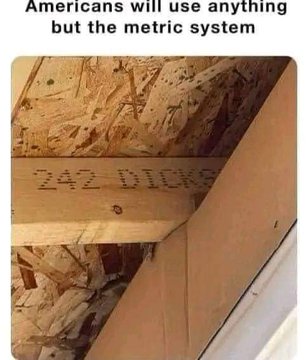this post was submitted on 23 Sep 2023
872 points (98.1% liked)
memes
11963 readers
2022 users here now
Community rules
1. Be civil
No trolling, bigotry or other insulting / annoying behaviour
2. No politics
This is non-politics community. For political memes please go to [email protected]
3. No recent reposts
Check for reposts when posting a meme, you can only repost after 1 month
4. No bots
No bots without the express approval of the mods or the admins
5. No Spam/Ads
No advertisements or spam. This is an instance rule and the only way to live.
A collection of some classic Lemmy memes for your enjoyment
Sister communities
- [email protected] : Star Trek memes, chat and shitposts
- [email protected] : Lemmy Shitposts, anything and everything goes.
- [email protected] : Linux themed memes
- [email protected] : for those who love comic stories.
founded 2 years ago
MODERATORS
you are viewing a single comment's thread
view the rest of the comments
view the rest of the comments

If you want to really make a European's head explode, ask them how big a 2x4 is
Is it not 2"X4"? Am I naïve?
It's not. It's 1.5" x 3.5". I don't know the history and wasn't able to find it in a quick search, but lumber sizes are usually a half inch less than the name would imply.
That only applies to the thickness and width, though. The length of a board should be as described (e.g. a "two by four by eight" would be eight feet long, but have a cross section of 1.5 by 3.5 inches)
It's funny that you used 2x4-8 as your example for length, because a 2x4-8 stud is not actually 8 foot. If you're looking for 8 foot 2x4, you need to be careful that you are buying true 8 foot boards, and not 8 foot studs.
That being said, that's the only board I'm familiar with that has a length that's not always true length
Oh, that is funny. Are the studs 7'9" so a board below and above them are 8' total?
Hah, stud
The story is that the wood used to be roughly 2x4 and by "roughly" I mean that the woodworker would have to throw away almost half an inch to even have a straight surface.
But when the machines to do that became common the mills started doing that work, and they saved the extra volume of essentially garbage that was shipped with every piece of wood.
It is when it's first cut. But then it gets dried and planed down.
https://yewtu.be/watch?v=WaJFudED5FQ
It’s actually 1.5 by 3.5 because of reasons.
As a legal requirement we don't specify materials in anything other than mm, cm and m. In the UK the imperial measurements are sometimes also shown in a store, to help old people know what they are buying, but I've never seen that anywhere in continental Europe. Architecture isn't drawn using imperial measurements, this system is used ad hoc by UK builders only. I like to torment these luddites by specifying in mm but mostly I avoid interacting with them because I don't want to have a Mars Climate Orbiter situation at my house.
Nominal sizing is not uniquely American any more (if it ever was? Idk honestly). Work with lots of Europeans who are used to it as much as we are.